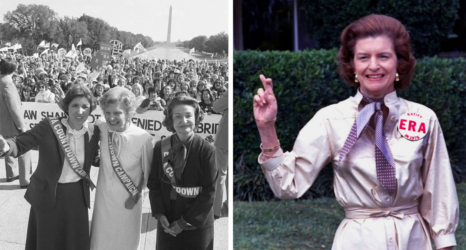So maybe the National Women’s Hall of Fame in Seneca Falls, N.Y., doesn’t have red-carpet glitz or high-tech razzle-dazzle.
But every other year, this home-grown organization brings hundreds of people to the little upstate New York village that was once home base for 19th century reformers and is now a bedroom community for nearby Syracuse and Rochester. The goal, to quote event organizers, is to remind us that, yes, “the achievements of a single individual can change the entire world and lead many others to their own greatness in the process.’’
Since its founding in the late 1960s, 247 women–from Bella Abzug to Oprah Winfrey–have been inducted into the Hall, and a modest exhibit that features a framed account of each inductee’s biography is displayed on the first floor of a former bank building at 78 Fall St., a stone’s throw from the historic Wesleyan Chapel where 300 men and women gathered for the first women’s rights convention in 1848.
This year’s 11 inductees are an awesome bunch–including the woman who inspired the Lilly Ledbetter Fair Pay Act of 2009–and those who gathered in the crowded gymnasium of the local chiropractic college for the Saturday night dinner and induction ceremony heard one spirit-lifting acceptance speech after another from them, or, in the case of those no longer living, from their “acceptors.’’ Marathon runner Kathrine Switzer recalled the moment in 1967 when organizers tried to physically remove her from the Boston Marathon because she was a woman; the late Coretta Scott King’s daughter, Bernice, bore witness to her mother’s commitment to civil rights activism by recalling how her mother ignored pleas that she “go home’’ after a bomb exploded in the Montgomery, Ala., home where she was staying in 1956; Loretta Ford recalled being a lightening rod as she worked to implement the now widely accepted nurse practioner model of health care. Ford, 91, brought down the house when she quipped: “ I have not been botoxed or detoxed. What you see is what you get. I am Loretta Ford and I approve of this message.’’
While the ceremony was moving, what makes a pilgrimage to Seneca Falls especially fun is that so many key sites are within walking distance. And even though the downtown looks a little down on its luck (all the mills that once kept Seneca Falls humming are now closed), it is not cluttered with chain stores.
On Saturday, I was able to easily navigate my way to the First Presbyterian Church where Alice Paul introduced the Equal Rights Amendment in 1923 to watch three amazing teenage girls from Colorado perform their original play about Alice Paul (1885-1977), Caroline Churchill (1833-1926) and Julia Ward Howe (1819-1910). From there, I grabbed a quick bite to eat at ZuZu’s Café (a tribute to the town’s alleged role as the inspiration for the movie It’s a Wonderful Life) before taking off for the Women’s Rights National Historic Center Visitors Center where historian Penny Colman discussed the writing of her latest book, Elizabeth Cady Stanton and Susan B. Anthony: A Friendship That Changed the World. I don’t think I walked more than five blocks.
The synergy was powerful. I had come to Seneca Falls to cheer on my favorite inductee (who I wrote this biography of)–founder of the first guide dog school for the blind, Dorothy Harrison Eustis (1886-1946)–but thanks to an impromptu conversation at the hotel breakfast table I ended up befriending a delegation from the Worcester (Mass.) Women’s History Project who spent years advocating for their inductee, the abolitionist Abby Kelley Foster. When a member of their delegation, the actor Lynne McKenney Lydick, dressed in period garb and taking on the persona of Abby Kelley Foster, accepted the award on Abby’s behalf, I was happy to be at Worchester table, cheering alongside them.
That’s the feeling organizers want to build on as they embark on plans to take the Hall of Fame to the next level. A big step forward was made in 2007 when the board purchased the Seneca Knitting Mill, an empty factory on the banks of the Seneca Canal that winds its way through town. Although fundraising has started, no specific timeline has been set for completing the renovation of the mill into the new home of the Hall, said executive director Christine A. Moulton.
Like the women’s movement that the Seneca Falls convention inspired, the mill has abolitionist roots. It was founded by Quakers who deliberately chose to make goods from wool rather than cotton because they didn’t want to use a raw material that was picked by slaves. The building itself is also a piece of woman’s history: During its 150-plus years of operation, it employed immigrant Irish and Italian women to make the woolen Seneca Mill socks that were sold around the world.
The group envisions multi-media exhibition spaces; a library, archive and research center; and a conference center to serve as a gathering place for students, scholars and visitors from around the world. The end result, Moulton says, will be “a community hearth as well as a national destination’’ that will serve as a vehicle for visitors to “discover their own greatness.’’
It’s a fitting, forward-thinking vision for an organization that, like the women’s suffrage movement, began modestly. It was a late-1960s’ brainchild of a now-retired secretary to the president of a local college, Shirley Hartley, who was motivated by a desire to embrace the legacy of Seneca Falls. In the early years, organizers hosted meetings at their kitchen tables and stored records in their basements, recalls board member Marilyn. P. Bero, a former third-grade teacher who spearheaded the community-wide efforts to raise the $175,000 needed to purchase the old bank building where the hall has lived since 1979.
Now the Hall is on the cusp of finding its own greatness.
Photo of 2011 inductee Billie Holiday from Flickr user fertilegroundportland under license from Creative Commons 2.0





